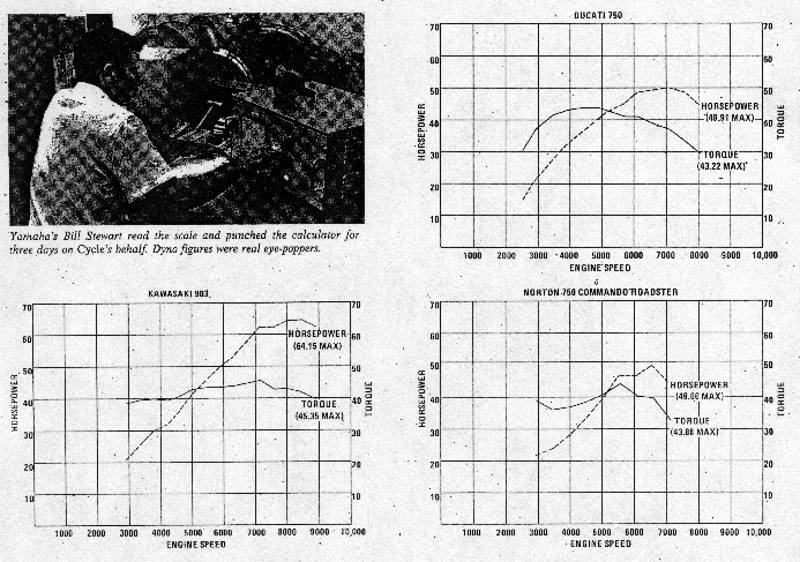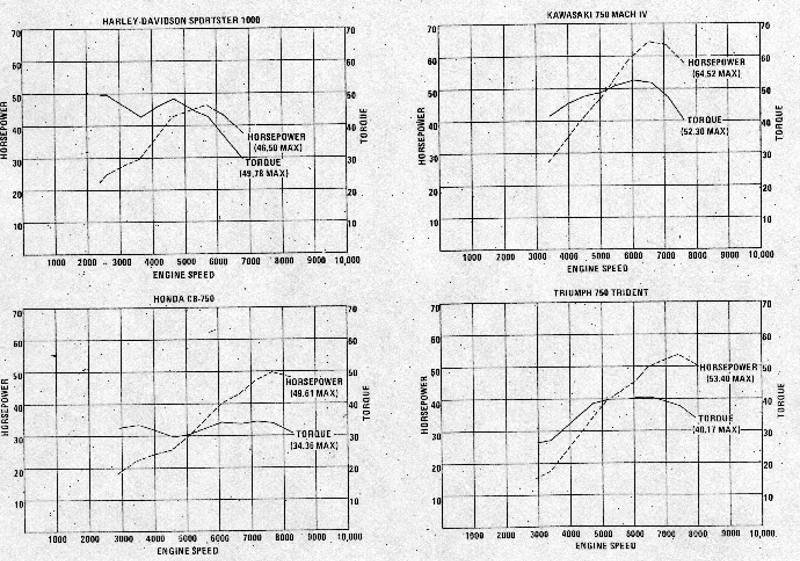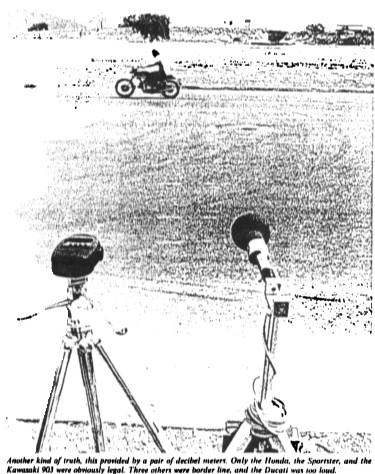
THE DYNO DOESN'T LIE
The dynamometer is another objective tool for comparing and measuring Superbike performance—only it’s more complicated than a stop watch and tape measure. The “Truth Machine” records engine torque figures, which are measurements expressing the amount of rotational force exerted by the crankshaft. This twisting force is what propels the motorcycle forward. Multiplying an engine’s torque by the rpm at which the torque occurs and dividing by 5252 (a mysterious constant found and explained in physics books) reveals horsepower at the rpm in question. Technically an engine’s maximum horsepower reflects the amount of force (torque) and time involved in moving the bike from point A to point B.
Since humidity, temperature and barometric pressure will effect an engine’s output, SAE correction factors are introduced into the final mathematics to compensate for these variables equally in each engine. Thus our final figures represent corrected rear wheel horsepower and true engine torque.
As in every other category so far, the Kawasakis swept the horsepower race with the 750 on top at 64.52 at 6555 rpm and the 903 just a flash behind—64.15 at 8440 revs. These figures are 11 horses above the third-place Triumph (53.40 hp). It was nearly a tie for the fourth, fifth, and sixth spots between the Ducati (49.61), Norton (49.66) and Honda (49.61). Severely restricted by its California mufflers, the Sportster bottomed out with 46.50 hp at 5724 rpm.
The all-conquering Kawasaki 750 also won the torque battle, snubbing the Sportster by 2.52 foot pounds—52.30 at 6037 rpm to 49.78 at a low, low 2471 revs. Next came the 903 with 45.35 foot-pounds at 7174 revs. Again the Norton and Ducati crowded the same spot with 43.88 and 43.22 foot-pounds respectively, followed by the Triumph in sixth place with 40.18 foot-pounds and finally the Honda, clearly last with 34.46.
To understand the dynamometer figures you must first understand that: 1) they are not touched by overall vehicle weight; 2) they do not take into consideration the torque multiplication properties of the gear-box; and 3) they simply reflect the amount of grunt the engine is capable of exerting against the resistance of the motorcycle’s inertia (a body at rest tends to remain at rest, and a body in motion tends to remain in motion).
If all of these considerations are kept in mind the dynamometer figures are intriguing insofar as they provide absolutes as to maximum torque and horsepower; they reinforce the drag strip figures; and they can give you an indication about any given motorcycle’s street performance.
The correlation between dynamometer horsepower, overall gear reduction, vehicle weight and drag performance is particularly interesting. The engine’s horsepower is not a constant—it varies with engine speed; and it produces its maximum over a relatively short engine speed range. The gearbox’s job is to keep the engine within its maximum horsepower-producing range, so that it is pushing against the motorcycle’s inertia as hard as it can for as long a period of time as possible. Example: the Trident. The Trident develops over 50 horsepower from 6500 rpm all the way to just under 8000. During the course of a quarter-mile maximum acceleration run Bob Ellison’s gearing selection kept the Trident engine over 6500rpm and under 8000 for the entire distance. As a consequence the engine was permitted to push as hard as it could against its particular resistance for the whole distance and spectacular times (considering its weight and its maximum power) were the result.


Or take the Kawasaki 750, thee quickest bike of all (12.28). Like the trident, it had been regeared. It produces over 60 horsepower from 6000 rpm to well over 7000 rpm. During the course of a run engine speed never dropped below 6000 and was never permitted to exceed 7000, so the Mach IV produced close to its maximum grunt for the whole distance. It weighs less than the Trident, so its particular resistance is lower, and it makes more power. The results are predictable: its times are substantially more impressive than the times of the Trident.
For contrast let’s look at the Sportster, the slowest bike in the test and the only one incapable of producing a 100-mph quarter-mile terminal speed. The XLCH’s best times resulted when gearshifts were made at just over 6500 rpm. With that shift point the engine was working against its particular resistance with between 44 and 46 horsepower—until the shift into fourth gear was made, at which point engine speed dropped down, horsepower production dropped down, and acceleration fell off. The engine doesn’t make very much (relative) power to begin with, and its four-speed gearbox doesn’t keep the engine close to its peak.
When studying the graphs notice at what rpm each engine begins pulling, what the horsepower and torque readings are at this point, how fast the curves rise and how long they are. Don’t assume that the bikes will differ in performance on the road by the same amount that they differ on paper. Weight plays havoc with direct translations from graph paper to interstate. For instance at roughly 3000 rpm the 903 Kawasaki produces 39.43 foot-pounds of torque and the Ducati 37.30. Yet out on the road the Ducati will kill the 903 in a high-gear throttle roll-on from 3000 Rs all the way up to 90 mph. This is because at 3000 rpm the Duke is carrying 12.58 pounds of weight per foot-pounds of torque compared to 13.75 pounds for the Kawasaki (based on wet weight of the motorcycle alone). The Ducati is able to stay ahead for so long because by 6000 rpm it still has an 11.46 to 12.50 pound per foot-pound of torque advantage. The Kawasaki catches the Duke at the 7000 rpm level, when it’s producing 45 plus foot-pounds and the V-twin has dropped to about 37 foot-pounds for an 11.95 to 12.75 pounds per foot-pound-of-torque advantage for the four-cylinder Kawasaki.
Running the bikes at full throttle under load for three or four minutes it takes to secure dyno figures is punishing and brutal torture for the engines. Thermocouples collared between the spark plug and head often indicated temperatures of 400-450º and the tachometer redlines went unheeded in an effort to extract the ultimate possible reading. Every bike emerged intact. A slipping clutch on the Norton’s second run was the only failure.
Careful observation of the Ducati revealed the pleated rubber hoses running from the air cleaner to carburetor were pinched practically closed in a terrible restriction of air. In the only bit of “experimental tuning” per-formed at the dyno we simply removed the hoses and promptly picked up 5 hp at the maximum rating. Our published figures are with the cleaners intact. What would the Duke have done at the drags without them?
When the dyno testing had been completed, only one motorcycle-—the 903—left us puzzled. Both it and the Mach IV had produced nearly identical quarter-mile figures –low twelves at 110 mph—and both had produced 64 horsepower on the dynamometer. But the 903 didn’t have the Mach IV’s gearing advantage, and it had to deal with a weight penalty of 73 pounds. Clearly the 903 had produced more horsepower on the drag strip than it had on the dynamometer. Why? Nobody knew—but bear in mind that the Z1 had been dismantled right before it went on the pump, and had been reassembled without the benefit of new rings or new valve guide seals, because no fresh parts existed for the brand-new four-cylinder. The Z1 had been sharp as a tack at the strip; mechanic Jeff Shelter felt that its fine-tune had evaporated during the reassembly.
One more comparative evaluation remained—the Superbikes would be asked to open there mouths, stick out their tongues, and say aaaah for the decibel meter.
HOW LOUD?
 Only one test remained before the Super-bikes would be hauled into the
Cycle shop, dismantled, inspected and released back to their respective
dealerships. Although the decibel figures would have no impact on the final
tally-sheet, they promised, like the dynamometer figures, to be eye-opening.
They were. Out of seven participating motorcycles, only the Sportster, the
Honda, and the 903 were clearly legal (within the confines of the California
88dB limit). The Trident, the Norton, and the Kawasaki 750 were
borderline-to-legal and the Ducati, as we had suspected earlier, was illegal
without question.
Only one test remained before the Super-bikes would be hauled into the
Cycle shop, dismantled, inspected and released back to their respective
dealerships. Although the decibel figures would have no impact on the final
tally-sheet, they promised, like the dynamometer figures, to be eye-opening.
They were. Out of seven participating motorcycles, only the Sportster, the
Honda, and the 903 were clearly legal (within the confines of the California
88dB limit). The Trident, the Norton, and the Kawasaki 750 were
borderline-to-legal and the Ducati, as we had suspected earlier, was illegal
without question.
While we have explicit faith in the accuracy of our own General Radio sound-level measuring equipment, we called upon the corporation of Bolt, Beranek, and Newman (an outfit that does sound-level work for the MIC) to assist us in this part of the test. We asked for their help for two reasons: we wanted our results to be accurate beyond a shadow of a doubt since we felt that several of the motorcycles in the test would be if not illegal, damn close to it; and we wanted the representatives of the manufactures involved to be without argument or recourse should our results cause them discomfort. As a double-check we located our own meter right next to BBN’s apparatus. Both meters gave identical readouts on all the motorcycles tested.
Of the seven bikes tested, the Honda, not surprisingly, was easily the quietest—80.5 dB (A), a full 7 ⅛ decibels under the California maximum. The 903 was next with readings that averaged 84.3, and it was followed by the Sportster at 85.8 well under the limit. Like the Honda the XLCH has paid a price for its manners with the coin of performance, but it was certainly worth it and Harley-Davidson has a lot to be proud of.
The rest of the bikes demonstrated that their manufacturers have a long way to go in noise control research. The Trident was marginal at 88.7, and so were the Kawasaki 750 (89.0) and the Norton (89.8). The Ducati wasn’t even close. Of its six passes, four were at 90, and two were at 91, for a failing average of 90.3, well beyond the 88 dB (A) boundary. Sure the Duke has an exciting, V-twin rumble—but the charm of the exhaust note could be retained without the irritation of the exhaust sound level. It sounds good. It doesn’t sound as good as the Sportster, which is legal.
INSPECTION
The excitement of the test over, all of the bikes went back to the Cycle shop to be stripped to their crankcases so that they could be checked for legality.
The fastest was first: no standard show-room motorcycle could be as quick as the 750 Kawasaki was in our test. But it was exactly stock. We measured port timing and pipe lengths and compression ratios and stuff on that bike for six hours. Jack Murphy hadn’t even knocked the casting imperfections out of the ports. But all the holes opened and closed at the right time. Even his gasoline was legal.
Although all of the other bikes proved to be as legal as the winner, several interesting things turned up in the process. Unknown to anyone we could talk to, the Honda’s cam-shaft seems to be five degrees retarded from the K-1 series figure, and the lobes don’t lift the valves quite as high as they did. No wonder the bike is slower. The Norton was sup-posed to have had a hot “Combat” cam in it, but our readings showed the magic stick to be a slightly worn SS cam instead. The Ducati really had us talking to ourselves for a while, until we laboriously deduced that the engine, indeed, turned backwards. Then the figures started to make sense. We thought that we had caught the Triumph boys trying to sneak one by, but it turns out that good old U.S. valve springs are being fitted to the bikes on the production line in England.
One by one, the tuners came to take their charges from us. They all carefully put the dismantled pieces in their vans and quietly drove away. All except the Honda guys: they put their engine together in two hours, hit the starter for half a second, and rode it out the door.
| Ducati 750 | H-D 1000 | Kawasaki 750 | Kawasaki 903 | Norton 750 | Honda 750 | Trident 750 | |
| Price | $1964 | $2025 | $1400 | $2000 | $1700 | $1700 | $1930 |
| Engine Type | OHC 90º 4-stroke twin |
45º 4-stroke twin |
piston-port 3-cylinder |
DOHC
4-stroke 4-cylinder |
360º vertical twin |
SOHC
4-stroke 4-cylinder |
4-stroke 3-cylinder |
| Bore & Stroke | 80mm x
74.4mm 3.12 x 290 |
81mm x 96mm 3.1875 x 3.8125 |
71mm x 63mm 2.80 x 2.48 |
66mm x 66mm 2.598 x 2.598 |
73mm x 89mm 2.88 x 3.5 |
61mm x 63mm 2.40 x 2.48 |
67mm x 70mm 2.64 x 2.76 |
| Displacement | 748cc | 1000cc | 748cc | 903cc | 745cc | 736cc | 741cc |
| Compression | 8.5:1 | 9.0:1 | 7.0:1 | 8.5:1 | 10:1 | 9.0:1 | 9.5:1 |
| Carburetion | (2) 30mm AMAL |
(1) 42mm Bendix |
(3) 30mm Mikuni VM |
(4) 28mm Mikuni VM |
(2) 32mm AMAL |
(4) 28mm Keihin |
(3) 27mm AMAL |
| Air Filtration | Pleated
Paper Element |
Filtron Element |
Foam Element |
Treated Synthetic Fiber |
Pleated
Paper Element |
Pleated
Paper Element |
Pleated
Wire Gauze |
| Ignition | Battery & Coil | Battery & Coil | Capacitive
Discharge |
Battery & Coil | Battery & Coil | Battery & Coil | Battery & Coil |
| Horsepower | 49.9@7114 | 46.5@5724 | 64.5@6555 | 64.2@8440 | 49.7@6574 | 49.6@7717 | 53.4@7435 |
| Torque | 43.2@4819 | 49.8@2602 | 52.3@6037 | 45.4@7174 | 43.9@5536 | 34.4@7191 | 40.2@6542 |
| Oil Capacity | 9 pints | 6 pints | 4.2 pints | 7.36 pints | 6 pints | 6.4 pints | 7 pints |
|
Gear Ratios Overall First |
12.32 | 11.16 | 12.62 | 12.79 | 12.40 | 13.29 | 12.91 |
| Second | 8.60 | 8.08 | 8.65 | 8.84 | 8.25 | 9.08 | 9.19 |
| Third | 6.63 | 6.11 | 6.52 | 6.74 | 5.90 | 7.09 | 6.98 |
| Fourth | 5.51 | 4.42 | 5.40 | 5.58 | 4.84 | 5.83 | 5.93 |
| Fifth | 4.89 | 4.75 | 4.92 | 4.99 | 4.98 | ||
| Wheelbase | 60" | 58.5" | 56.5" | 59" | 56.75" | 57" | 57" |
| Seat Height | 30.5" | 28.75" | 32.5" | 31.5" | 32" | 31.5" | 31" |
| Ground Clearance | 6" | 7" | 6" | 6" | 5.75" | 5.25" | 6" |
| Weight Wet | 469 lbs | 487.5 lbs | 469 lbs | 542 lbs | 439 lbs | 526 lbs | 497 lbs |
| Test Weight | 629 lbs | 647.5 lbs | 629 lbs | 702 lbs | 599 lbs | 686 lbs | 657 lbs |
| Brake, Front | 11x1.5 | 10x21/8 | 11x1.6 | 11.5x1.75 | 10.7x1.65 | 11.7x1.65 | 10x15/8 |
| Brake, Rear | 7.87 x 1.15" | 8 x1.625" | 1.4 x 7.8" | 7.9 x 1.4" | 7.5 x 1.25" | 7.1 x 1.6" | 7.0 x 1.125" |
| Front Tire | 3.25 x 19 | 3.50 x 19 | 3.25 x 19 | 3.25 x 19 | 4.10 x 19 | 3.25 x 19 | 4.10 x 19 |
| Rear Tire | 3.50 x 18 | 4.25 x 18 | 4.00 x 18 | 4.00 x 18 | 4.10 x 19 | 4.00 x 18 | 4.10 x 19 |
|
Gear Ratios - ¼ Mile First |
12.32 | 11.16 | 12.95 | 12.79 | 12.40 | 14.95 | 14.13 |
| Second | 8.60 | 8.08 | 8.87 | 8.84 | 8.25 | 10.21 | 10.06 |
| Third | 6.63 | 6.11 | 6.69 | 6.74 | 5.90 | 7.97 | 7.64 |
| Fourth | 5.51 | 4.42 | 5.54 | 5.58 | 4.84 | 6.56 | 6.49 |
| Fifth | 4.89 | 4.87 | 4.92 | 5.61 | 5.45 | ||
| Lap Time | 46.4 | 48.0 | 44.5 | 44.5 | 45.6 | 47.0 | 45.3 |
|
Braking Distance |
61.01 mph 137'10" |
60.32 mph 145'3" |
59.52 mph 128'5" |
59.01 mph 126'5" |
60.16 mph 131'11½" |
59.28 mph 131'1½" |
61.64 mph 142'10½" |
|
Braking Force |
0.902 G | 0.830 G | 0.922 G | 0.920 G | 0.916 G | 0.895 G | 0.889 G |
| Sound Level | 90.3 | 85.8 | 89.0 | 84.3 | 89.8 | 80.5 | 88.7 |
| ¼ - Mile ET | 13.289 sec | 13.393 sec | 12.283 sec | 12.386 sec | 12.896 sec | 13.497 sec | 12.718 sec |
| ¼ - Mile Speed | 101.12 mph | 99.88 mph | 110.29 mph | 110.70 mph | 104.77 mph | 100.67 mph | 106.00 mph |